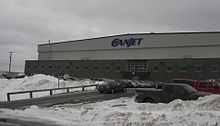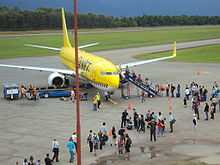CanJet
|
| ||||
| ||||
| Founded | June 20, 2002 | |||
|---|---|---|---|---|
| Operating bases |
Montréal- Trudeau International Airport Halifax Robert L. Stanfield International Airport Toronto Pearson International Airport Vancouver International Airport | |||
| Fleet size | 8 | |||
| Destinations | 37 | |||
| Parent company | I.M.P. Group International Inc. | |||
| Headquarters | Enfield, Nova Scotia | |||
| Key people | Kenneth C. Rowe (CEO) | |||
| Website | Canjet.com | |||


CanJet Airlines is a low-cost chartered airline based in Enfield and in the Halifax Regional Municipality, Nova Scotia, Canada at the Halifax International Airport.[1][2] It operates contract and ad hoc charters throughout Canada and the United States. CanJet is wholly owned by IMP Group International and has 572 employees (as of March 2007).[3]
Before September 10, 2006, CanJet served 15 cities in Canada and the United States as a discount passenger airline. On September 5, 2006, CanJet announced it would cease scheduled flights but would continue to operate as a chartered airline.[4]
History
1999-2001: before merger with Canada 3000
The airline was established in 1999 and started operations on September 5, 2000. It was launched as a division of IMP Group and merged with Canada 3000 in May 2001 shortly before Canada 3000's bankruptcy.
2002-2006: scheduled operations

CanJet was successfully relaunched on June 20, 2002 as an independent airline. Originally the airline flew to three destinations, but quickly expanded. Canjet operated a fleet of nine Boeing 737-500 — seven of which were formerly operated by United Airlines, one by Lufthansa — and one Boeing 737-300. These airframes date back to the early 1990s. There were plans to expand the airline's fleet of Boeing 737-500 aircraft to 20 by 2006; however, this did not materialize.
In April 2004, CanJet launched services at Hamilton/John C. Munro International Airport, Hamilton to fill a void left after WestJet shifted its eastern Canada hub to Toronto Pearson International Airport.
In May 2005, the company began to expand into the western Canadian market with a flight between Calgary and Toronto, with plans to slowly expand to other western markets. In the wake of the bankruptcy of Jetsgo, the company hoped to fill some of that company's market share, but also hoped to expand slowly to avoid the fate of other companies such as Canada 3000. In June 2005, two weeks after Air Canada Jazz announced new service to Hamilton/John C. Munro International Airport from Montreal and Ottawa, CanJet announced it would end its service to Hamilton. In August 2005, CanJet announced new service to Fort Lauderdale, Florida from Toronto.
In May 2006, CanJet and Harmony Airways signed a marketing pact to allow greater cross country service. CanJet would end flights west of Toronto, and focus more on Atlantic flights. This pact allowed consumers to book flights with both companies and have their luggage transferred between the two airlines.
2006-present: charter operations
On September 5, 2006, CanJet announced that on September 10, 2006, it would cancel all regularly scheduled service and focus instead on charter service because of the highly competitive nature of the airline industry in Canada, and the resulting slim profit margins. Ken Rowe, IMP Chairman and CEO, said, "with the rising business risks of operating a scheduled airline, IMP has decided to suspend year-round scheduled airline service and focus on their increasing charter business." CanJet stated that any passengers who had bought tickets for travel dates after September 10, 2006 would either be provided with a full refund, or be provided with alternate travel arrangements.[5]
On September 27, 2006, CanJet announced that it would rehire more than 100 airline pilots and flight attendants; about 20% of the number initially laid-off on September 10, 2006 as the company regained a contract to fly chartered flights for tour operator, Sunquest.[6]
2009: Transat partnership
On February 13, 2009, CanJet announced a five-year partnership with Montreal based Transat AT. Since 1 May 2009, Transat Tours Canada has charter CanJet's Boeing 737 aircraft flying from Canadian cities to various destinations. This replaced an agreement with Calgary based Westjet.[7]
Destinations
Fleet
As of December 2012, the CanJet fleet has an average age of 10 years.[8]
| Aircraft | In Fleet | Passengers | Notes |
|---|---|---|---|
| Boeing 737-800 | 8 | 189 | All aircraft are leased |
Historical fleet
Over the years, CanJet operated the following aircraft types:[9]
| Aircraft | Introduced | Retired |
|---|---|---|
| Boeing 737-200 | 2000 | 2005 |
| Boeing 737-300 | 2006 | 2010 |
| Boeing 737-500 | 2004 | 2008 |
| Boeing 737-800 | 2007 | |
Onboard service
CanJet provides free hot meals on all flights (except USA flights) with a free glass of wine, non-alcoholic beverages, coffee and tea on all flights. Pizza and sandwiches are available for purchase on USA flights, with free non-alcoholic beverages, coffee and tea. Snacks and alcoholic beverages are available for sale. On southbound flights, a free glass of sparkling wine is provided on board. Pillow & blanket comfort travel kits, and headsets for in-flight entertainment are available for purchase on board.
Incidents and accidents
On April 19, 2009, CanJet Flight 918 was taken over by an armed man who slipped through security checks at Sangster International Airport, Montego Bay, Jamaica. All passengers were released early on, but six CanJet crew members were kept as hostages for several hours. The hostages were eventually rescued by Jamaican Police, who successfully stormed the aircraft, following negotiations that involved Jamaican Prime Minister Bruce Golding.[10]
References
- ↑ "Map." Halifax Regional Municipality. Retrieved on March 2, 2011.
- ↑ "Contact Us." CanJet. Retrieved on December 29, 2010. "CanJet Airlines - Head Office P.O. Box 980 Enfield, Nova Scotia CANADA B2T 1R6"
- ↑ "Directory: World Airlines". Flight International. 2007-04-03. p. 60.
- ↑ CanJet website - Press Release
- ↑ Discount carrier CanJet cancels scheduled service as of Sept. 10
- ↑ CanJet will rehire 100 pilots, attendants, says CEO
- ↑ Transat and CanJet forge 5-year partnership for narrow-body aircraft
- ↑ CanJet fleet list at planespotters.net
- ↑ CanJet fleet list at airfleets.net
- ↑ euronews - Hijack drama in Jamaica ends without incident
External links
| Wikimedia Commons has media related to CanJet. |